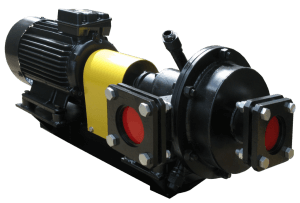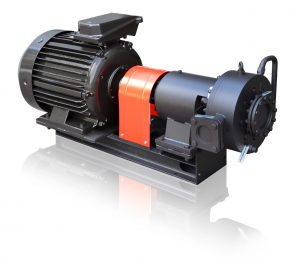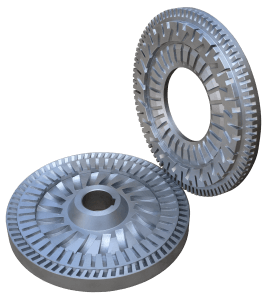Dispersing solids
A colloid is a substance microscopically dispersed throughout another substance.[1]
The dispersed-phase particles have a diameter of between approximately 1 and 1000 nanometers.[2] Such particles are normally invisible in an optical microscope, though their presence can be confirmed with the use of anultramicroscope or an electron microscope. Homogeneous mixtures with a dispersed phase in this size range may be called colloidal aerosols, colloidal emulsions, colloidal foams, colloidal dispersions, or hydrosols. The dispersed-phase particles or droplets are affected largely by the surface chemistry present in the colloid.
Some colloids are translucent because of the Tyndall effect, which is the scattering of light by particles in the colloid. Other colloids may be opaque or have a slight color.
Colloidal solutions (also called colloidal suspensions) are the subject of interface and colloid science. This field of study was introduced in 1861 by Scottish scientist Thomas Graham.
Classification
Because the size of the dispersed phase may be difficult to measure, and because colloids have the appearance of solutions, colloids are sometimes identified and characterized by their physico-chemical and transport properties. For example, if a colloid consists of a solid phase dispersed in a liquid, the solid particles will not diffuse through a membrane, whereas with a true solution the dissolved ions or molecules will diffuse through a membrane. Because of the size exclusion, the colloidal particles are unable to pass through the pores of an ultrafiltration membrane with a size smaller than their own dimension. The smaller the size of the pore of the ultrafiltration membrane, the lower the concentration of the dispersed colloidal particules remaining in the ultrafiltered liquid. The exact value of the concentration of a truly dissolved species will thus depend on the experimental conditions applied to separate it from the colloidal particles also dispersed in the liquid. This is particularly important for solubility studies of readily hydrolysed species such as Al, Eu, Am, Cm, or organic matter complexing these species.
Colloids can be classified as follows:
| Medium / Phases | Dispersed phase | |||
|---|---|---|---|---|
| Gas | Liquid | Solid | ||
| Continuous medium | Gas | NONE (All gases are mutually miscible) |
Liquid aerosol Examples: fog, hair sprays |
Solid aerosol Examples: smoke, ice cloud, air particulates |
| Liquid | Foam Example: whipped cream, shaving cream |
Emulsion Examples: milk, mayonnaise, hand cream |
Sol Examples: pigmented ink, blood |
|
| Solid | Solid foam Examples: aerogel, styrofoam, pumice |
Gel Examples: agar, gelatin, jelly |
Solid sol Example: cranberry glass |
|
Based on the nature of interaction between the dispersed phase and the dispersion medium, colloids can be classified as: Hydrophilic colloids: These are water-loving colloids.The colloid particles are attracted toward water. They are also called reversible sols. Hydrophobic colloids: These are opposite in nature to hydrophilic colloids. The colloid particles are repelled by water. They are also called irreversible sols.
In some cases, a colloid can be considered a homogeneous mixture. This is because the distinction between “dissolved” and “particulate” matter can be sometimes a matter of approach, which affects whether or not it is homogeneous or heterogeneous.
Hydrocolloids
A hydrocolloid is defined as a colloid system wherein the colloid particles are hydrophilic polymers dispersed in water. A hydrocolloid has colloid particles spread throughout water, and depending on the quantity of water available that can take place in different states, e.g., gel or sol (liquid). Hydrocolloids can be either irreversible (single-state) or reversible. For example, agar, a reversible hydrocolloid of seaweed extract, can exist in a gel and solid state, and alternate between states with the addition or elimination of heat.
Many hydrocolloids are derived from natural sources. For example, agar-agar and carrageenan are extracted from seaweed, gelatin is produced by hydrolysis of proteins of bovine and fish origins, and pectin is extracted from citrus peel and apple pomace.
Gelatin desserts like jelly or Jell-O are made from gelatin powder, another effective hydrocolloid. Hydrocolloids are employed in food mainly to influence texture or viscosity (e.g., a sauce). Hydrocolloid-based medical dressings are used for skin and wound treatment.
Other main hydrocolloids are xanthan gum, gum arabic, guar gum, locust bean gum, cellulose derivatives as carboxymethyl cellulose, alginate and starch.
Based on the nature of interaction between the dispersed phase and the dispersion medium, colloids can be classified as: Hydrophilic colloids: These are water-loving colloids.The colloid particles are attracted toward water. They are also called reversible sols. Hydrophobic colloids: These are opposite in nature to hydrophilic colloids. The colloid particles are repelled by water. They are also called irreversible sols.
Interaction between particles
The following forces play an important role in the interaction of colloid particles:
Excluded volume repulsion: This refers to the impossibility of any overlap between hard particles.
Electrostatic interaction: Colloidal particles often carry an electrical charge and therefore attract or repel each other. The charge of both the continuous and the dispersed phase, as well as the mobility of the phases are factors affecting this interaction.
van der Waals forces: This is due to interaction between two dipoles that are either permanent or induced. Even if the particles do not have a permanent dipole, fluctuations of the electron density gives rise to a temporary dipole in a particle. This temporary dipole induces a dipole in particles nearby. The temporary dipole and the induced dipoles are then attracted to each other. This is known as van der Waals force, and is always present (unless the refractive indexes of the dispersed and continuous phases are matched), is short-range, and is attractive.
Entropic forces: According to the second law of thermodynamics, a system progresses to a state in which entropy is maximized. This can result in effective forces even between hard spheres.
Steric forces between polymer-covered surfaces or in solutions containing non-adsorbing polymer can modulate interparticle forces, producing an additional steric repulsive force (which is predominantly entropic in origin) or an attractive depletion force between them. Such an effect is specifically searched for with tailor-made superplasticizers developed to increase the workability of concrete and to reduce its water content.
Preparation
There are two principal ways of preparation of colloids:[3]
Dispersion of large particles or droplets to the colloidal dimensions by milling, spraying, or application of shear (e.g., shaking, mixing, or high shear mixing).
Condensation of small dissolved molecules into larger colloidal particles by precipitation, condensation, or redox reactions. Such processes are used in the preparation of colloidal silica or gold.
Stabilization (peptization)
The stability of a colloidal system is the capability of the system to remain as it is.
Stability is hindered by aggregation and sedimentation phenomena, which are driven by the colloids tendency to reduce surface energy. Reducing the interfacial tension will stabilize the colloidal system by reducing this driving force.
Examples of a stable and of an unstable colloidal dispersion.
Aggregation is due to the sum of the interaction forces between particles.[4][5] If attractive forces (such as van der Waals forces) prevail over the repulsive ones (such as the electrostatic ones) particles aggregate in clusters.
Electrostatic stabilization and steric stabilization are the two main mechanisms for stabilization against aggregation.
Electrostatic stabilization is based on the mutual repulsion of like electrical charges. In general, different phases have different charge affinities, so that an electrical double layer forms at any interface. Small particle sizes lead to enormous surface areas, and this effect is greatly amplified in colloids. In a stable colloid, mass of a dispersed phase is so low that its buoyancy or kinetic energy is too weak to overcome the electrostatic repulsion between charged layers of the dispersing phase.
Steric stabilization consists in covering the particles in polymers which prevents the particle to get close in the range of attractive forces.
A combination of the two mechanisms is also possible (electrosteric stabilization). All the above mentioned mechanisms for minimizing particle aggregation rely on the enhancement of the repulsive interaction forces.
Electrostatic and steric stabilization do not directly address the sedimentation/floating problem.
Particle sedimentation (and also floating, although this phenomenon is less common) arises from a difference in the density of the dispersed and of the continuous phase. The higher the difference in densities, the faster the particle settling.
The gel network stabilization represents the principal way to produce colloids stable to both aggregation and sedimentation.[6][7]
The method consists in adding to the colloidal suspension a green biopolymer able to form a gel network and characterized by shear thinning properties. Examples of such substances are xanthan and guar gum.
Steric and Gel network stabilization.
Particle settling is hindered by the stiffness of the polymeric matrix where particles are trapped.[6] In addition, the long polymeric chains can provide a steric or electrosteric stabilization to dispersed particles.
The rheological shear thinning properties find beneficial in the preparation of the suspensions and in their use, as the reduced viscosity at high shear rates facilitates deagglomeration, mixing and in general the flow of the suspensions.
Destabilization (flocculation)
Unstable colloidal dispersions can form flocs as the particles aggregate due to interparticle attractions. In this way photonic glasses can be grown. This can be accomplished by a number of different methods:
Removal of the electrostatic barrier that prevents aggregation of the particles. This can be accomplished by the addition of salt to a suspension or changing the pH of a suspension to effectively neutralize or “screen” the surface charge of the particles in suspension. This removes the repulsive forces that keep colloidal particles separate and allows for coagulation due to van der Waals forces.
Addition of a charged polymer flocculant. Polymer flocculants can bridge individual colloidal particles by attractive electrostatic interactions. For example, negatively-charged colloidal silica or clay particles can be flocculated by the addition of a positively-charged polymer.
Addition of non-adsorbed polymers called depletants that cause aggregation due to entropic effects.
Physical deformation of the particle (e.g., stretching) may increase the van der Waals forces more than stabilization forces (such as electrostatic), resulting coagulation of colloids at certain orientations.
Unstable colloidal suspensions of low-volume fraction form clustered liquid suspensions, wherein individual clusters of particles fall to the bottom of the suspension (or float to the top if the particles are less dense than the suspending medium) once the clusters are of sufficient size for the Brownian forces that work to keep the particles in suspension to be overcome by gravitational forces. However, colloidal suspensions of higher-volume fraction form colloidal gels with viscoelastic properties. Viscoelastic colloidal gels, such as bentonite and toothpaste, flow like liquids under shear, but maintain their shape when shear is removed. It is for this reason that toothpaste can be squeezed from a toothpaste tube, but stays on the toothbrush after it is applied.
Measurement principle of multiple light scattering coupled with vertical scanning
Multiple light scattering coupled with vertical scanning is the most widely used technique to monitor the dispersion state of a product, hence identifying and quantifying destabilisation phenomena.[8][9][10][11] It works on concentrated dispersions without dilution. When light is sent through the sample, it is backscattered by the particles / droplets. The backscattering intensity is directly proportional to the size and volume fraction of the dispersed phase. Therefore, local changes in concentration (e.g.Creaming and Sedimentation) and global changes in size (e.g. flocculation, coalescence) are detected and monitored.
What is a high speed emulsifying machine?
The CLM colloid mill is specifically designed bitumen emulsion colloid mill, developed for production of highly stable colloidal solutions, superfine suspensions, blends and emulsions. The mill features wet grinding due to the gap between rotor and stator cones being larger at the inlet and smaller at the outlet.


The product in the mill is ground between the rotating and stationary calibrated cylindrical radially skewed teeth of the rotor and stator. Additionally, the complex geometry of the rotor surface create increased turbulence, which shears particles.

The product in the colloid mill is ground between the rotating and stationary calibrated cylindrical radially skewed teeth of the rotor and stator.
The centrifugal force and high velocity of the rotor relative to the fixed stator cause liquid and semi-liquid materials to become homogenic and finely dispersed.
The colloid mill simultaneously disperses and homogenizes materials.
A heat jacket allows to apply or dissipate heat to or from the grinding zone.
The colloid mill features high performance capacity, allows to produce highly stable emulsions, as well as colloidal suspensions, ensures high degree of homogenization and particle size to 1 micron.
Processes are intensified by 100 – 600% compared with a turbine agitator – colloid mill built into a production line and does not require additional tanks.
Besides, the device creates cavitation, i.e. explosion of caverns by internal pressure.
The colloid mill can be retrofitted into existing production lines.
For high quality grinding the product must enter the mill in certain proportions at constant rate.
The degree of granulation and pumping qualities may vary depending on the mechanical properties of the material and the carrier phase.
| № | Parameter | CLM – 4.1 |
| 1 | ***Capacity rated (on the water), m3/hour, up to. | 4 |
| 2 | Operating pressure, bar. | 0,5 |
| 3 | Rotation speed, RPM. | 3000 |
| 4 | **Max heat carrier temperature, °С. | 160 |
| 5 | **Minimum coolant temperature, °С. | -4 |
| 6 | Dispersion, microns. | <50 |
| 7 | Nominal pressure/suction bore diameter, mm. | 32/65 |
| 8 | Drive power, kW. | 5,5 |
| 9 | *Dimensions, mm:
– length – width – height |
960 310 400 |
| 10 | Weight, kg. | 125 |
Note.
* – Dimensions are driven assembly.
** – If necessary, the product can be either heated or cooled to a desired temperature.
*** – Depending on the physical and chemical characteristics of the product capacity may vary.
The main advantages of the wet grinding GlobeCore colloid mills are:
- Modern design and high quality of the device
- Competitive price
- Competent engineering consulting
- Fast production of the order
- The efficiency and speed of mixing at times more than a turbine agitator
- Savings on storage capacity compared with a turbine agitator – colloid mill built into a production line and does not require additional tanks
- Stability of the mix to stratification
- Heating/cooling jacket
- High-tech production lines and qualified staff (over 200) allows to expedite orders
- Ability to adjust the gap of the grinding zone without the need to remove the device from the production line
- Grinding to 1 micron
- Component parts from universally recognized manufacturers
- Operating temperature range from -30 С° to 180 С°
- Optional soundproofing
Clients speak about GlobeCore mills:
|
|
Mr. Shekanabo, the United Republic of Tanzania: “I can only say good things about GlobeCore mills. After seeing the production facility, I had no doubts that this is a serious and reliable company with professional staff, and the system works like a clock. Of course, the production itself seems complicated, but the equipment is powerful and rugged.” |
 |
Mr. Patel, the United Republic of Tanzania: “I want to wish GlobeCore success in the future and I think we will maintain our cooperation for many more years. May you have as many successful products and new developments as possible.” |
For making an order feel the questionnaire or call us.
Follow us in social networks:

